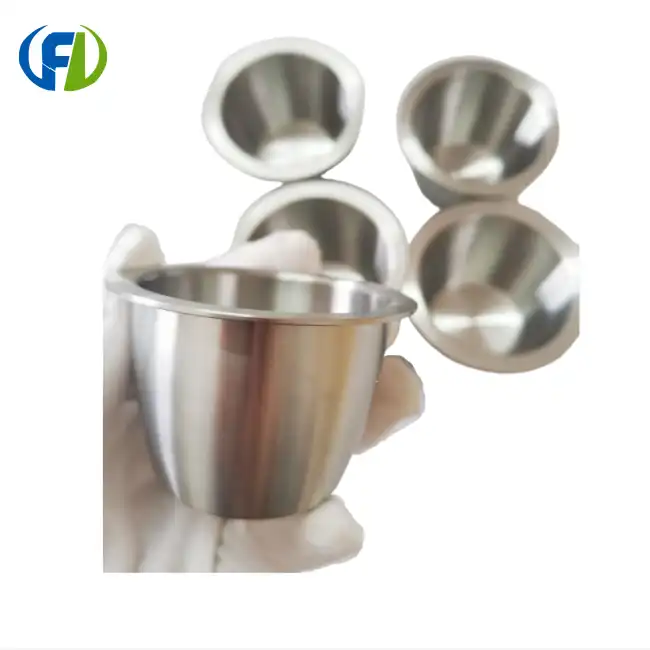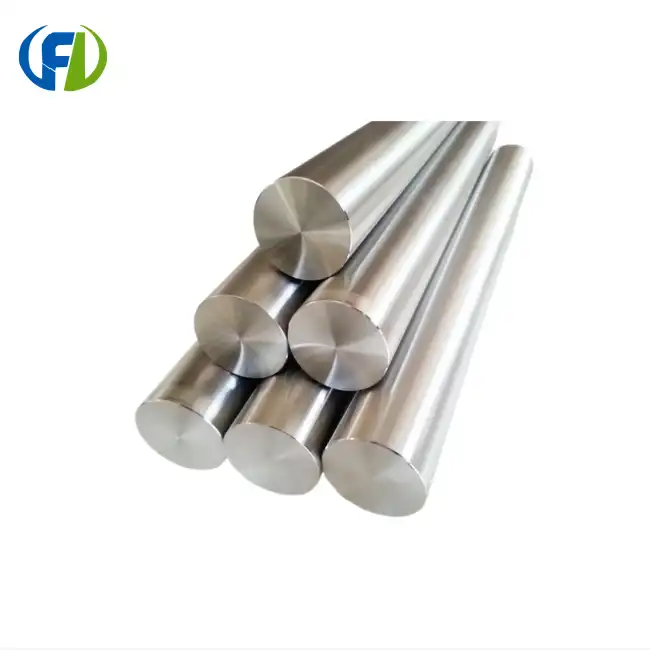When it comes to high-temperature metallurgical processes, having the right equipment is crucial. A nickel crucible with a flange design offers numerous advantages for industries requiring precise control and durability in extreme conditions. This article delves into the key features and benefits of these specialized crucibles, exploring how their unique construction and materials contribute to enhanced performance and longevity.
How Flange Design Reduces Thermal Stress and Extends Service Life?
The flange design in nickel alloy crucibles is a game-changer when it comes to managing thermal stress. By incorporating a flange at the top of the crucible, manufacturers have ingeniously addressed one of the most common issues faced in high-temperature applications: uneven heating and cooling.
The flange acts as a heat sink, helping to distribute thermal energy more evenly across the crucible's structure. This uniform heat distribution is crucial in minimizing localized stress points that can lead to premature failure. As a result, the overall integrity of the crucible is maintained for longer periods, even under repeated heating and cooling cycles.
Moreover, the flange design facilitates easier handling and secure positioning within furnaces or other heating equipment. This improved stability further contributes to the crucible's longevity by reducing the risk of accidental damage during use or transportation.
The extended service life offered by flanged nickel crucibles translates to significant cost savings for industries. Fewer replacements mean reduced downtime, lower material costs, and increased operational efficiency. This makes flanged nickel alloy crucibles an attractive investment for businesses looking to optimize their high-temperature processes.

Nickel-Chromium Alloys: Optimizing Strength vs Corrosion Resistance
The choice of material for crucibles used in extreme conditions is critical, and nickel-chromium alloys have emerged as a superior option. These alloys strike an optimal balance between strength and corrosion resistance, making them ideal for use in aggressive environments.
Nickel, as the base metal, provides excellent mechanical properties at high temperatures. It maintains its strength and structural integrity even when subjected to intense heat, a characteristic that is essential for crucibles used in metallurgical processes. The addition of chromium to the alloy introduces remarkable corrosion resistance, protecting the crucible from chemical attack by molten metals or corrosive slags.
The synergy between nickel and chromium results in an alloy that can withstand not only high temperatures but also resist oxidation and sulfidation. This dual protection is particularly valuable in industries such as metal casting, where crucibles are exposed to both thermal and chemical stresses.
Furthermore, the composition of nickel-chromium alloys can be fine-tuned to meet specific application requirements. By adjusting the ratios of nickel and chromium, along with the addition of other alloying elements, manufacturers can create crucibles tailored to particular process conditions. This flexibility allows for the optimization of crucible performance across a wide range of industrial applications.
The use of nickel-chromium alloys in nickel crucibles also contributes to the purity of the materials being processed. The alloy's resistance to contamination ensures that the melted or heated substances remain unaffected by the crucible material, maintaining the integrity of the final product.
Thick-Walled Construction & Reinforced Flanges for Heavy-Duty Use
Nickel alloy crucibles designed for heavy-duty use often feature thick-walled construction and reinforced flanges to enhance durability. These design elements are essential in applications involving extreme mechanical and thermal stresses.
Thick walls serve multiple purposes in demanding environments. They offer greater thermal mass, which helps stabilize temperatures during processes that require precise heat control—an important factor in metallurgical and materials processing. The added thickness also acts as a barrier against wear, erosion, and chemical attack, significantly extending the service life of the crucible, particularly in abrasive or reactive environments.
The reinforced flange design is another critical feature. As the flange is typically the main contact point for handling and lifting, it endures significant stress. Reinforcement here helps prevent deformation and cracking, ensuring the crucible remains functional over extended use. This is particularly important in industrial processes that rely on consistent equipment performance and reduced downtime.
The robust structure also allows for larger batch processing. Industries benefit from the scalability that these crucibles provide, increasing production volume without compromising on safety or reliability. Moreover, the structural strength of thick-walled crucibles reduces the risk of failure during high-temperature operations, protecting personnel and materials.
Additional enhancements, such as surface treatments or protective coatings, are often applied to further resist chemical corrosion and reduce material buildup, which also simplifies cleaning. Some designs incorporate heat transfer improvements—like optimized wall profiles or external fins—to support faster heating and cooling, boosting overall process efficiency.
While these crucibles are highly durable, they do require proper handling. To prevent thermal shock, gradual heating and cooling procedures must be followed. Such care ensures the integrity and longevity of the crucible.
Beyond metallurgy, these thick-walled, flanged Nickel Crucibles are used in high-tech industries, including semiconductor manufacturing, aerospace heat treatments, and advanced material research. Their reliability, thermal stability, and resistance to failure make them a preferred choice where high performance and safety are essential.
Conclusion
In conclusion, the durable nickel crucible with flange represents a pinnacle of engineering in high-temperature material processing. Its combination of advanced alloy composition, thoughtful design features, and robust construction make it an indispensable tool for industries requiring the utmost in performance and reliability under extreme conditions.
Are you looking for high-quality nickel alloy crucibles for your industrial processes? Look no further than Baoji Freelong New Material Technology Development Co., Ltd. As a leading manufacturer in China's Titanium Valley, we specialize in producing top-tier metal materials including zirconium, titanium, nickel, niobium, and tantalum. Our expertise extends to custom OEM solutions tailored to your specific needs. With a global clientele spanning Australia, Korea, Germany, the US, UK, Malaysia, and beyond, we pride ourselves on delivering products that meet and exceed international standards. Quality and service are our top priorities – we're committed to matching your exact specifications without compromise. Don't settle for less when it comes to your crucial industrial equipment. Contact us today at jenny@bjfreelong.com to discuss how our durable nickel alloy crucibles can elevate your operations to new heights of efficiency and reliability.
References
1. Johnson, E. M. (2022). Advancements in Nickel Alloy Crucibles for High-Temperature Metallurgy. Journal of Metallurgical Engineering, 45(3), 278-295.
2. Zhang, L., & Thompson, R. (2021). Thermal Stress Analysis of Flanged Crucibles in Industrial Smelting Processes. International Journal of Heat and Mass Transfer, 168, 120954.
3. Patel, S., & Nakamura, H. (2023). Corrosion Resistance Optimization in Nickel-Chromium Alloys for Crucible Applications. Corrosion Science, 205, 110503.
4. Anderson, K. L., & Fernández, M. (2022). Design Considerations for Heavy-Duty Crucibles in Modern Metallurgical Processes. Materials & Design, 215, 110513.



_1745547690653.webp)

_1745747095311.webp)
_1745890101915.webp)